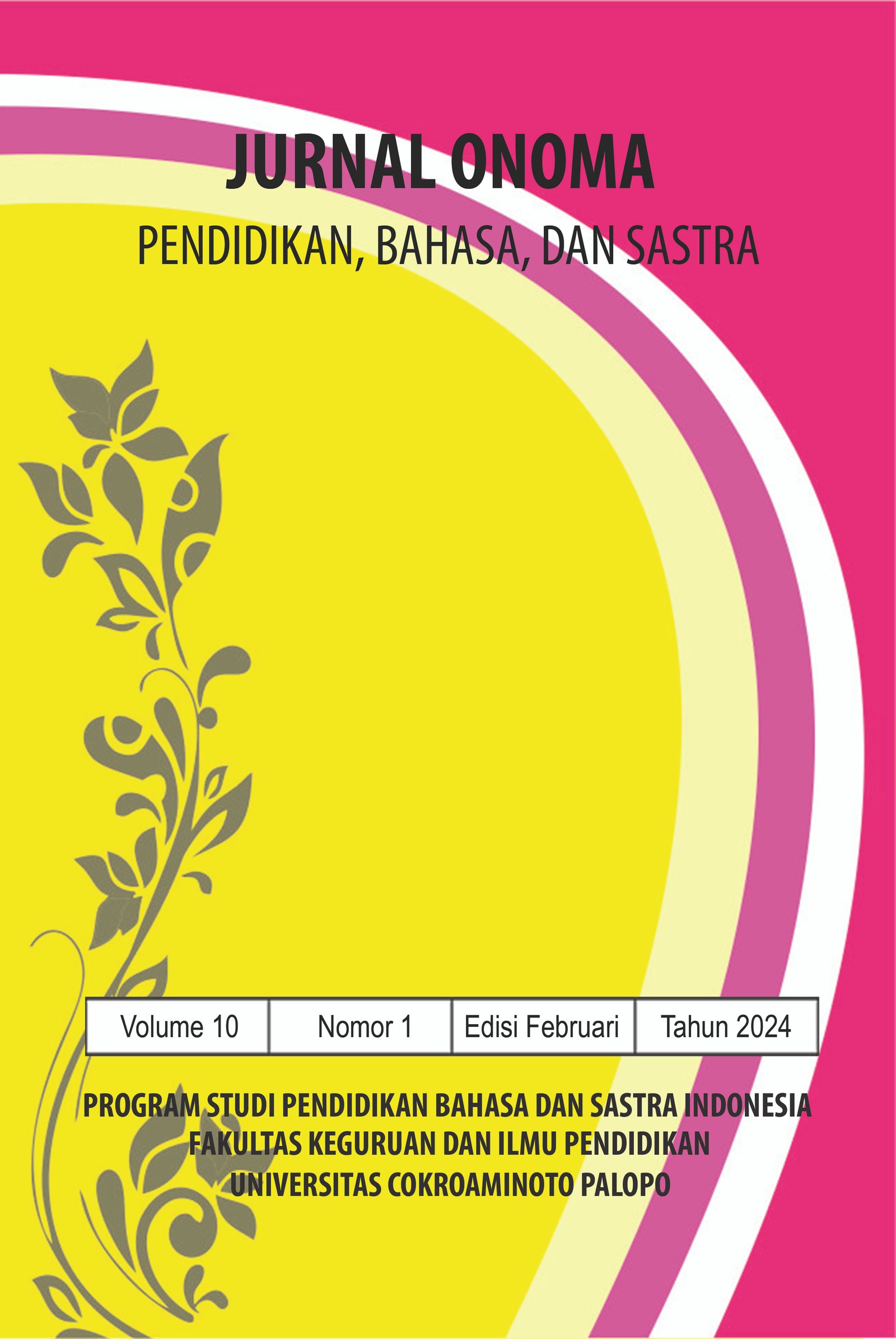Sarcasm in Social Media: A Study of Comments on Sam Smith's Instagram Posts
https://doi.org/10.30605/onoma.v10i1.3077
Keywords:
Sarcasm, types of sarcasm, purpose of sarcasm, Sam Smith Instagram accountAbstract
This study aims to explain the types of sarcasm expressions and determine the purpose of sarcsm used by netizens in Sam Smith's Instagram comment column. Descriptive qualitative was used in this research. The objects of the research were sarcasm in netizen comments on Sam Smith's Instagram posts and their intended meaning. Documentation was employed to collect the research data and content analysis was employed to observe the sarcasm. The findings revealed that four types of sarcasm were used by netizens to comment Sam Smith's Instagram posts, including propositional, lexical, like - prefix, and illocutionary sarcasm. The study found five purposes of sarcasm: sophistication, evaluation, politeness, persuassive communication, and retraction.
Downloads
References
Andriani, M.Y. (2019). A Pragmatics Analysis Of Sarcastics Utterance On Homeland - Pilot Tv Series Script. Surakarta: Universitas Muhammadiyah Surakarta.
Attardo, S. (2000). Irony markers and functions: Towards a goal-oriented theory of irony and its processing.
Attardo, S. (2000). Journal of Pragmatics. Irony as relevant inappropriateness, 793-826.
Bachtiar, E. S. & Hardjanto, D. H. (2018). Sarcastic Expressions in Two American Movies. Yogyakarta : University of Gajdah Mada.
Camp, E. (2011). Sarcasm, pretense, and the semantics/pragmatics distinction. Amerika Serikat: University of Pennsylvania.
Caucci, G. & Kreuz, R. (2012). Social and paralinguistic cues to sarcasm. International Journal of Humor Research, 25(1), 1-22.
Chaer, Abdul. (2009). Psikolinguistik Kajian Teoritik. Jakarta: Rineka Cipta.
Chusna, U. I. (2022). Sarcasm In the Comment Column Of Joe Biden’s Instagram Post. Malang: Universitas Negeri Maulana Malik Ibrahim.
Creswell, J. W. (1994). Research design: Qualitative & quantitative approaches. Thousand Oaks, Calif: Sage Publications.
Cross, Michael. (2013). Social Media Security, 1st Edition: Leveraging Social Networking While Mitigating Risk. Syngress
Fitriyanti, Amalia Ilmi (2020) Creative Thinking Portrayed from Sarcasm of the Netizens' Comments in Donald Trump's Instagram Account. Undergraduate thesis, Universitas Islam Negeri Maulana Malik Ibrahim.
Fox, W., & Bayat, M. S. (2007). A Guide to Managing Research. Cape Town City: Juta Publications. https://research-methodology.net/descriptive-research/#_ftn2
Gay, L.R., Mills, GE., & Airasian, P. (2006). Educational Research: Competencies for Analysis and Application. New Jersey: Pearson Prentice Hall.
Kreuz, J. K. & Glucksberg, S. (1989). How to be sarcastic: The echoic reminder theory of verbal irony. Journal of Experimental Psychology: General, 118, 374-386.
Lambert, V. A., & Lambert, C. E. (2012). Qualitative Descriptive Research: An Acceptable Design. Pacific Rim International Journal of Nursing Research, 16, 255-256.
Lestari, J. P, & Juita, N. (2022). Types of Sarcasm in the Comment Column of Male Netizen on the Youtube Account of Sukmawati Soekarno Putri News Video. Sumatra Barat: Universitas Negeri Padang
Maula, Q. C. A. & Muhayani, U. (2022). Sarcastics Expression In The News of Mulan Live – Action Movie By China Uncensored Youtube Chanel. Yogyakrta : University of Gajdah Mada.
Melawati, L. P. ( 2021). An Analysis of Sarcasm In Marvel’s Movie “Venom””. Wonosbo: University of Sains Al-Qur’an.
Muhaddisi, A, Prastowo, B.N, & Putri, D.U.K. (2021). Sentiment Analysis with Sarcasm Detection On Politician’s Instagram. IJCCS (Indonesian Journal of Computing and Cybernetics Systems), 15, 4, 349 - 358.
Padmatantri, P, & Sutrisno, A. (2019). Responses to Sarcasm in Three Star Trek Movies. Journal of Lexicon, 6, 1, 11-20.
Puji Lestari, J.P & Juita, N. (2022). Types of Sarcasm in the Comment Column of Male Netizen on the Youtube Account of Sukmawati Soekarno Putri News Video. Sumatra Barat: Universitas Negeri Padang.
Ramadhan, R.T & Setiasari, W. (2022). A Study of Sarcasm of TV Series Friends. Journal of English Language Teaching and Learning, 11, 4, 185-197.
Sitanggang, E.M, Ningsih, T.W. (2022). Sarcasm Used By Netizens On Twitter Case of Election Bidden – Trump Era. ISLLAC: Journal of Intensive Studies on Language, Literature, Art, and Culture, 6, 01.
Sukarto, K.A & Fauziah, F. (2022). Satire and Sarcasm on the “You Tube Got Talent" Video: A Case Study on Skinnyindonesian24 Channel. ELS Journal on Interdisciplinary Studies in Humanities, 5, 2. https://doi.org/10.34050/elsjish.v5i2.21725
Downloads
Published
How to Cite
License
In submitting the manuscript to the journal, the authors certify that:
- They are authorized by their co-authors to enter into these arrangements.
- The work described has not been formally published before, except in the form of an abstract or as part of a published lecture, review, thesis, or overlay journal.
- That it is not under consideration for publication elsewhere,
- That its publication has been approved by all the author(s) and by the responsible authorities – tacitly or explicitly – of the institutes where the work has been carried out.
- They secure the right to reproduce any material that has already been published or copyrighted elsewhere.
- They agree to the following license and copyright agreement.
License and Copyright Agreement
Authors who publish with Onoma Journal: Education, Languages??, and Literature agree to the following terms:
- Authors retain copyright and grant the journal right of first publication with the work simultaneously licensed under Creative Commons Attribution License (CC BY 4.0) that allows others to share the work with an acknowledgment of the work's authorship and initial publication in this journal.
- Authors are able to enter into separate, additional contractual arrangements for the non-exclusive distribution of the journal's published version of the work (e.g., post it to an institutional repository or publish it in a book), with an acknowledgment of its initial publication in this journal.
- Authors are permitted and encouraged to post their work online (e.g., in institutional repositories or on their website) prior to and during the submission process, as it can lead to productive exchanges, as well as earlier and greater citation of published work.

















